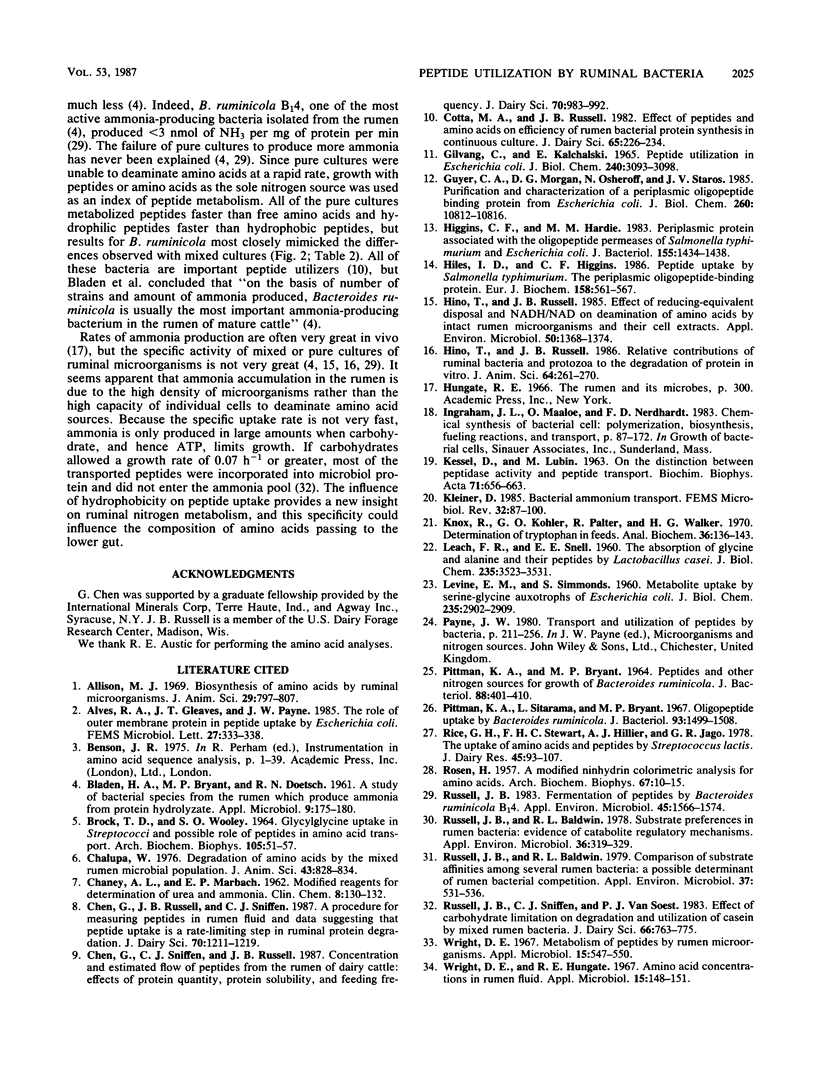Abstract
When mixed ruminal bacteria were incubated with a pancreatic casein hydrolysate and free amino acids of a similar composition, rates of ammonia production were much greater for peptides than for amino acids. The pancreatic digest of casein was then fractionated with 90% isopropyl alcohol. Hydrophobic peptides which dissolved in alcohol contained an abundance of phenolic and aliphatic amino acids, while the hydrophilic peptides which were precipitated by alcohol contained a large proportion of the highly charged amino acids. The Km values of the mixed ruminal bacteria for each fraction were similar (0.88 versus 0.98 g/liter), but the Vmax of the hydrophilic peptides was more than twice that of the hydrophobic peptides (18 versus 39 mg of NH3 per g of bacterial protein per h). Pure cultures of ruminal bacteria had a similar preference for hydrophilic peptides and likewise utilized peptides at a faster rate than free amino acids. Since peptide degradation rates differed greatly, hydrophobicity is likely to influence the composition of amino acids passing unfermented to the lower gut of ruminant animals.
Full text
PDF




Selected References
These references are in PubMed. This may not be the complete list of references from this article.
- Allison M. J. Biosynthesis of amono acids by ruminal microorganisms. J Anim Sci. 1969 Nov;29(5):797–807. doi: 10.2527/jas1969.295797x. [DOI] [PubMed] [Google Scholar]
- BROCK T. D., WOOLEY S. O. GLYCYLGLYCINE UPTAKE IN STREPTOCOCCI AND A POSSIBLE ROLE OF PEPTIDES IN AMINO ACID TRANSPORT. Arch Biochem Biophys. 1964 Apr;105:51–57. doi: 10.1016/0003-9861(64)90234-6. [DOI] [PubMed] [Google Scholar]
- Bladen H. A., Bryant M. P., Doetsch R. N. A Study of Bacterial Species from the Rumen Which Produce Ammonia from Protein Hydrolyzate. Appl Microbiol. 1961 Mar;9(2):175–180. doi: 10.1128/am.9.2.175-180.1961. [DOI] [PMC free article] [PubMed] [Google Scholar]
- CHANEY A. L., MARBACH E. P. Modified reagents for determination of urea and ammonia. Clin Chem. 1962 Apr;8:130–132. [PubMed] [Google Scholar]
- Chalupa W. Degradation of amino acids by the mixed rumen microbial population. J Anim Sci. 1976 Oct;43(4):828–834. doi: 10.2527/jas1976.434828x. [DOI] [PubMed] [Google Scholar]
- Chen G., Russell J. B., Sniffen C. J. A procedure for measuring peptides in rumen fluid and evidence that peptide uptake can be a rate-limiting step in ruminal protein degradation. J Dairy Sci. 1987 Jun;70(6):1211–1219. doi: 10.3168/jds.S0022-0302(87)80133-9. [DOI] [PubMed] [Google Scholar]
- Chen G., Sniffen C. J., Russell J. B. Concentration and estimated flow of peptides from the rumen of dairy cattle: effects of protein quantity, protein solubility, and feeding frequency. J Dairy Sci. 1987 May;70(5):983–992. doi: 10.3168/jds.S0022-0302(87)80103-0. [DOI] [PubMed] [Google Scholar]
- GILVARG C., KATCHALSKI E. PEPTIDE UTILIZATION IN ESCHERICHIA COLI. J Biol Chem. 1965 Jul;240:3093–3098. [PubMed] [Google Scholar]
- Guyer C. A., Morgan D. G., Osheroff N., Staros J. V. Purification and characterization of a periplasmic oligopeptide binding protein from Escherichia coli. J Biol Chem. 1985 Sep 5;260(19):10812–10818. [PubMed] [Google Scholar]
- Higgins C. F., Hardie M. M. Periplasmic protein associated with the oligopeptide permeases of Salmonella typhimurium and Escherichia coli. J Bacteriol. 1983 Sep;155(3):1434–1438. doi: 10.1128/jb.155.3.1434-1438.1983. [DOI] [PMC free article] [PubMed] [Google Scholar]
- Hiles I. D., Higgins C. F. Peptide uptake by Salmonella typhimurium. The periplasmic oligopeptide-binding protein. Eur J Biochem. 1986 Aug 1;158(3):561–567. doi: 10.1111/j.1432-1033.1986.tb09791.x. [DOI] [PubMed] [Google Scholar]
- Hino T., Russell J. B. Effect of reducing-equivalent disposal and NADH/NAD on deamination of amino acids by intact rumen microorganisms and their cell extracts. Appl Environ Microbiol. 1985 Dec;50(6):1368–1374. doi: 10.1128/aem.50.6.1368-1374.1985. [DOI] [PMC free article] [PubMed] [Google Scholar]
- Hino T., Russell J. B. Relative contributions of ruminal bacteria and protozoa to the degradation of protein in vitro. J Anim Sci. 1987 Jan;64(1):261–270. doi: 10.2527/jas1987.641261x. [DOI] [PubMed] [Google Scholar]
- KESSEL D., LUBIN M. On the distinction between peptidase activity and peptide transport. Biochim Biophys Acta. 1963 Jun 4;71:656–663. doi: 10.1016/0006-3002(63)91139-9. [DOI] [PubMed] [Google Scholar]
- Knox R., Kohler G. O., Palter R., Walker H. G. Determination of tryptophan in feeds. Anal Biochem. 1970 Jul;36(1):136–143. doi: 10.1016/0003-2697(70)90341-6. [DOI] [PubMed] [Google Scholar]
- LEACH F. R., SNELL E. E. The absorption of glycine and alanine and their peptides by Lactobacillus casei. J Biol Chem. 1960 Dec;235:3523–3531. [PubMed] [Google Scholar]
- LEVINE E. M., SIMMONDS S. Metabolite uptake by serineglycine auxotrophs of Escherichia coli. J Biol Chem. 1960 Oct;235:2902–2909. [PubMed] [Google Scholar]
- PITTMAN K. A., BRYANT M. P. PEPTIDES AND OTHER NITROGEN SOURCES FOR GROWTH OF BACTEROIDES RUMINICOLA. J Bacteriol. 1964 Aug;88:401–410. doi: 10.1128/jb.88.2.401-410.1964. [DOI] [PMC free article] [PubMed] [Google Scholar]
- Pittman K. A., Lakshmanan S., Bryant M. P. Oligopeptide uptake by Bacteroides ruminicola. J Bacteriol. 1967 May;93(5):1499–1508. doi: 10.1128/jb.93.5.1499-1508.1967. [DOI] [PMC free article] [PubMed] [Google Scholar]
- ROSEN H. A modified ninhydrin colorimetric analysis for amino acids. Arch Biochem Biophys. 1957 Mar;67(1):10–15. doi: 10.1016/0003-9861(57)90241-2. [DOI] [PubMed] [Google Scholar]
- Russell J. B., Baldwin R. L. Comparison of substrate affinities among several rumen bacteria: a possible determinant of rumen bacterial competition. Appl Environ Microbiol. 1979 Mar;37(3):531–536. doi: 10.1128/aem.37.3.531-536.1979. [DOI] [PMC free article] [PubMed] [Google Scholar]
- Russell J. B., Baldwin R. L. Substrate preferences in rumen bacteria: evidence of catabolite regulatory mechanisms. Appl Environ Microbiol. 1978 Aug;36(2):319–329. doi: 10.1128/aem.36.2.319-329.1978. [DOI] [PMC free article] [PubMed] [Google Scholar]
- Russell J. B. Fermentation of Peptides by Bacteroides ruminicola B(1)4. Appl Environ Microbiol. 1983 May;45(5):1566–1574. doi: 10.1128/aem.45.5.1566-1574.1983. [DOI] [PMC free article] [PubMed] [Google Scholar]
- Russell J. B., Sniffen C. J., Van Soest P. J. Effect of carbohydrate limitation on degradation and utilization of casein by mixed rumen bacteria. J Dairy Sci. 1983 Apr;66(4):763–775. doi: 10.3168/jds.S0022-0302(83)81856-6. [DOI] [PubMed] [Google Scholar]
- Wright D. E., Hungate R. E. Amino acid concentrations in rumen fluid. Appl Microbiol. 1967 Jan;15(1):148–151. doi: 10.1128/am.15.1.148-151.1967. [DOI] [PMC free article] [PubMed] [Google Scholar]
- Wright D. E. Metabolism of peptides by rumen microorganisms. Appl Microbiol. 1967 May;15(3):547–550. doi: 10.1128/am.15.3.547-550.1967. [DOI] [PMC free article] [PubMed] [Google Scholar]


